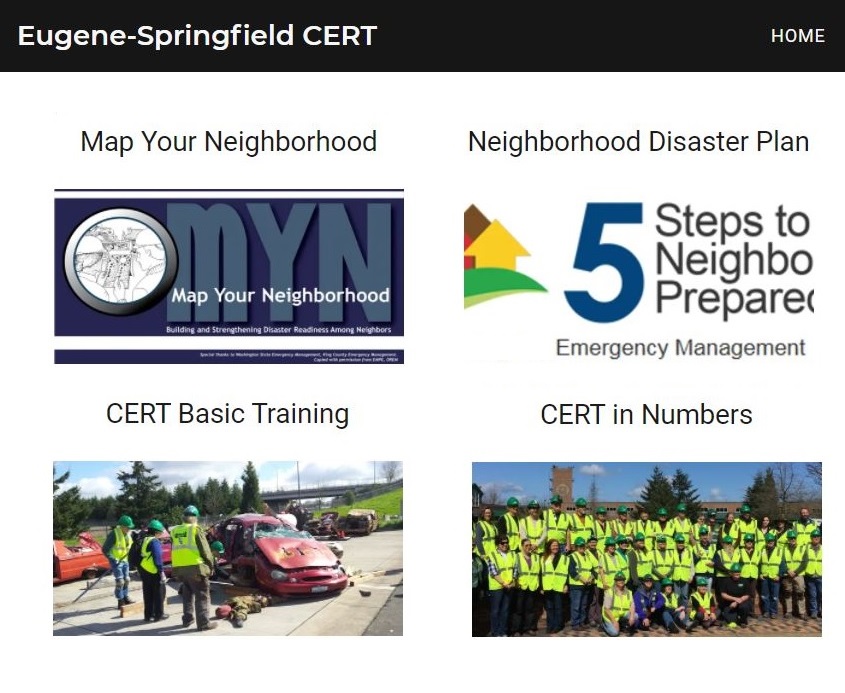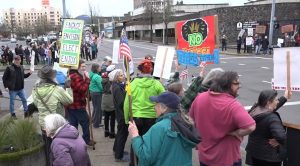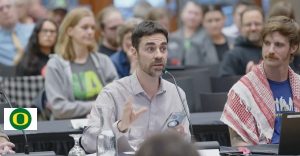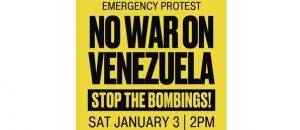Eugene neighborhoods step up to help during disasters
6 min read
The Eugene-Springfield CERT program provides specialized response training and exercises for local residents.
The Holiday Farm Fire showed that during a disaster, emergency responders are overwhelmed. Neighbors can do their part by watching out for nearby neighbors. From Northeast Eugene, Andy Davis.
Andy Davis: [00:00:13] I grew up in the cold war era in the fifties and sixties, and I remember nuclear shelters. And I remember people having the civil defense helmets and things like that, people that volunteered for that. If you remember watching some of the old war movies, they have these civil defense people, volunteers, as they walk the street, telling people to turn their lights off. So it’s the same thing like that.
We have to step up and give back to the community. We just can’t leave it up to the government to do it for us. We have to help ourselves. And that goes for personal preparedness for emergencies along with our family or household. And to our neighbors and then to the district that we live in, we have to help one another.
John Q: [00:00:57] One way neighbors can help is to collect information, then communicate with responders.
Andy Davis: [00:01:03] After a major disaster, their first hour or so, the first responders are going to basically be doing a windshield survey and really not stopping to help anyone, but actually going around evaluating what are their priorities. So the emergency management asked if I would be able to maybe take this on come up with some type of a system, some type of emergency communication net that could provide information to the Eugene emergency operation center and first responders, of the needs of the community.
Thank you for supporting
local civic journalism
You got to have an infrastructure in place in order for a system to work and you need the people dedicated that they want to serve their community, and give up their times. And this is one of the ways if you’re an amateur radio operator, you can assist your community that you live in by providing emergency message traffic, to the emergency operation center to send help to one of your fellow neighbors.
If you’re not an amateur radio operator, but you live in a neighborhood, you could be a participant of a Map Your Neighborhood team. That basically is a field team that goes out and walks your neighborhood, looking to see who needs help, and then pass that information back to your local neighborhood ham that is close by.
John Q: [00:02:20] Andy organized and conducted an exercise last Saturday, June 12.
Andy Davis: [00:02:26] For this exercise, I’ll be the Northeast Neighbors neighborhood net control, dealing with the neighborhood hams. Taking a filled out damage assessment form, pretending like a neighborhood person has given it to them, and then taking the information important information from that damage assessment form, put it into a ICS-213 general message, and then over the airways to to the neighborhood net control and then on up to the district net control and then to the EOC emergency operations center.
So it’s going to be a good practice to discern what information from the damages assessment form needs to go on the (ICS-)213 because we don’t want to be wordy or mouthy on the air, because there’s other people that have important messages they want to send as well. So we don’t want to take up a lot of time on the air.
John Q: [00:03:21] I.C. S. stands for Incident Command System. That is the system FEMA uses to allow teams of emergency responders to work together.
Andy Davis: [00:03:31] Yeah, I guess the biggest hurdle for folks is working with the ICS forms because usually the only ones that are familiar with ICS forms are your Community Emergency Response Team. The ICS system is foreign to everyone else, but an ICS system is a nationwide standard that is in place for all our first responders and FEMA. And it’s a standard, it’s a good standard, but it means that everybody across the nation that is experienced with it and has knowledge of it, they can step in anywhere and actually work along and it can follow along and understand. And so that’s what we were using, where you, because we work we’re we’ll be working hand in hand with first responders and in the emergency operation center and they are dealing with the incident command system.
And along with a standard of the ICS system, the Neighborhood Response Guide is a standard for all the neighborhoods and in Eugene, including all the hams and the net controls so that we are all on the same page. So we, if we were working with the Response Guide, we’re all speaking the same language. So it’s a great resource, a great tool all the way down for the Map Your Neighborhood team person to utilize, even with the block captain to utilize the resource guide even the ham operator and then in the ham net control.
John Q: [00:05:01] Andy said a review after the exercise will help them fine-tune their response.
Andy Davis: [00:05:06] I’m only dealing with the hams within my neighborhood and once they pass me their traffic, then I have to pass it on to the district net control. Now the district net control, he’s going to be a lot more busy, which is Mike Barger. As we say in the south, he’s going to be as busy as a one-armed paper hanger in a roomful of alligators. So he is going to be busy because he’s going to be dealing with the other, once the other two neighborhoods come online, he’ll be dealing with, for neighborhood net controls, dealing with all of their traffic. So he will be busy. And the district net control may have to have needs for additional ham operators. Want to maybe take care of each of the neighborhoods so net and district net control is not overwhelmed so much with traffic for this.
John Q: [00:05:56] After practicing with the ham radio operators this summer, Andy plans for city-wide exercises this fall. He said it helps to start small and build up from there.
Andy Davis: [00:06:08] My background military wise was electronics. And so in school, when they taught us about a radar system or something like that, they didn’t say show us the whole schematic of the whole system. Cause it’d be overwhelmed. So they would teach us block by block. So we would, and once we’re finished through all the blocks, we have mastered the complete schematic. So it wasn’t so overwhelming that way. And then this is the same way.
John Q: [00:06:34] Map Your Neighborhood is a program encouraged by the City of Eugene, based on neighbors helping neighbors.
Andy Davis: [00:06:40] It’s to support and encourage the neighbors to get to know one another and have a Map Your Neighborhood team that in an emergency that will go and check on their next door neighbors or the neighbor down the block. Mrs. Wilson she’s takes medication how’s Mrs. Wilson doing and we’ve lost power. Does Mrs. Wilson meds need refrigeration? So who has an emergency generator that can keep the power going? Maybe we could put Mrs. Wilson’s meds in that refrigerator so that she can keep. Keep up with their meds.
So things like that it’s neighbor helping neighbor and working together as a team, so to speak. But we just, we do need the people to do that and working together and we try in the CERT program tries to promote that and help out with whatever we can.
John Q: [00:07:29] In the fall exercises, Andy hopes the neighborhood field team, and the ham radio operator, can practice together.
Andy Davis: [00:07:38] September, hopefully, we can join in with the Map Your Neighborhood teams and give them pictures to look at and have them write up damages assessment forms, and then pass it on FRS radio to a ham radio operator, which in turn will then transport it to another (ICS-)213 and on up the chain. That’s the goal for September. It won’t be so new and maybe not so overwhelming.
Yes, we are playing a game or we are practicing, but we’re practicing to save lives. And so the longer that we are keeping messages from not going through may endanger lives.
John Q: [00:08:19] There are many ways to get involved. You can support your nearby neighbors, or learn specialized response skills through the CERT program, or get your own ham radio license. To get started, contact your local neighborhood association.





